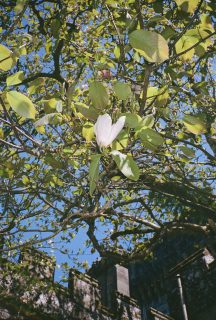Midwinter Magnolia — The Pleasure of Anticipation

by Molly Collet
There are many ways to measure the passing of time – stopwatches; sundials; pencil marks going up the kitchen wall of your childhood home. My favorite method, come midwinter, is by looking to my city’s magnolia trees.
I live in Brooklyn’s Fort Greene neighborhood, which is, as the name suggests, densely populated with trees. (Although it’s more like Fort Grey in February, with hardly a leaf in sight.) As far as marking the passage of winter goes, though, most of these trees are not up to task. They start and end the season looking exactly the same: rather skeletal and bleak. The magnolia trees, on the other hand, are specially equipped for the job because they put out their buds in the autumn. These velvety sage pods, dotted along the tree’s silver branches, grow over the course of the winter; a proxy for the season’s progress.
Magnolias are the world’s oldest flowering tree, so they know a thing or two about time. The earliest magnolias appear in the fossil record as far back as the Cretaceous period, a full 95 million years ago. Indeed, if you look at these trees closely, you’ll notice something rather ancient about them, as if they wouldn’t look out of place at the Natural History Museum or doing tai chi with the grannies in the park. Even today’s youngest magnolia buds have a vaguely fossilized, Yoda-like presence. In this way, magnolia trees remind me of sand dollars, horseshoe crabs, and other remnants of the prehistoric era. At once familiar and otherworldly, they have that distinct peculiarity of a species that comes not from another place, but another time.
These prehistoric origins may also explain how magnolias are able to so casually survive the blistering East Coast winter. As New Yorkers are facing the elements multi-layered in balaclavas and puffers, the magnolia buds are out here with only the faintest covering of fuzz. Leaving my apartment dressed like the Michelin Man’s girlfriend, I am, frankly, humbled. The buds have been rained, hailed, and snowed on. Bearded with frost, their branches fringed with icicles. Whatever the weather, they remain completely unbothered; the N.Y.C. winter has got nothing on the literal Ice Age.
This fuzzy exterior belies the magnolia bud’s immense strength. Its outermost layer is incredibly tough, serving to protect and insulate the nascent flowers within. The buds are soft but stubborn, like all the best-loved women in my life.
Because they have the entire winter to prepare for spring, the magnolias are in no rush whatsoever. Rather, they indulge in the quiet, interior joys of hibernation. This means that, as a unit of measurement, magnolia buds can feel infinitesimally small. They grow at a glacial pace. One week they are roughly the size of a coffee bean, and the next week they are… still roughly the size of a coffee bean. Sometimes it does feel as though the buds have stopped developing altogether, that we are stuck in a Narnia-adjacent eternal winter hellscape.
Even in the bleakest moments, though, these silvery pockets hold within them the tightly curled promise of spring. Because of this, a magnolia bud tells you both more and less about time than a calendar. Calendars mark linear time. They tell you how many days have passed since autumn and how many more are left until spring. But they don’t tell you, like buds do, about how time can be folded in on itself; that even in the depths of winter, spring is germinating, emergent.
Soon enough, February will thaw into March and then April. My neighborhood’s magnolia trees will erupt, like a cloudburst, from bud to bloom. In the powdery abundance of spring, they will unfurl their spoon-like petals, opalescent and waxy as moons.
But for now, all we have are the washed-out final weeks of winter and these elongated moments of craving, wanting, waiting. In this amphetamine-fast city, with its perpetual motion and drive for instant gratification, the midwinter magnolia doesn’t just measure time passing. It sets its own pace—a tree from the ancient past that serves as a reminder not to rush into the future. Turn down the heat. Let it simmer. There’s pleasure in anticipation.
Molly Collett is a lifestyle writer based in NYC. Her work has been published in publications including the Wall Street Journal and the Financial Times. @molly_mouth